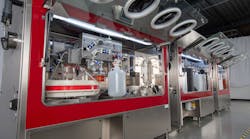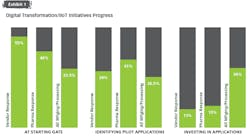Many pharmaceutical industry analysts have pointed to the Internet of Things (IoT) and the Pharma Industrial Internet as the keys to providing the transparency and traceability pharmaceutical manufacturers need to meet the ever-expanding array of serialization requirements and regulations, and to optimizing their production processes in order to compete in today’s marketplace.
As early as 2014, in a survey conducted by Forrester, in collaboration with Zebra, 80% of respondents indicated that IoT would represent the most strategic technological initiative for their organizations in the past decade. This is significant indeed. But before we dive into what this ‘strategic technological initiative’ might mean for your labeling, let’s zero in on what we mean by “the Pharma Industrial Internet”.
The Pharma Industrial Internet, or the pharma industry digital transformation, as it’s also been called, has been defined as the digital transformation of the pharmaceutical product supply infrastructure, from manufacturing to packaging and dispensing to patient delivery. So what will your labeling process look like once this transformation is complete?
GOODBYE PAPER
In a recent survey of 100 key decision makers in the pharma and biopharma industries, almost one-third of the companies surveyed still relied on a paper-based label catalog and approval process. In the world of the Pharma Industrial Internet, paper-based catalogs and manual checks are things of the past. All of the information needed to produce and maintain labels has gone digital. Data can be accessed and updated in real time. It is readily accessible so that manufacturers can track and trace products in the event of an issue and can correct errant information more quickly and efficiently.
A NEW APPROACH TO QUALITY CONTROL
Despite all of the modern advancements we’ve seen in quality control, the number of drug recalls is actually going up. It’s increased by 65% over the past 10 years. In 2016, the FDA reported 77 drug recalls due to product labeling errors. And when each recall comes with an average price tag of around USD 8 million, suddenly label quality becomes business-critical.
In the world of the Pharma Industrial Internet, best practice quality control will be about having the right technologies at each stage of the production process so you can validate that each step has been completed according to the specifications and requirements defined for that process. The right technologies would include a modern label management system that can facilitate the transition from paper-based processes to full digitalization and provide the necessary transparency and track and trace capabilities to monitor label production.
FROM FRAGMENTED TO UNIFIED
In the survey mentioned earlier, 62% of respondents stated they needed to print labels across multiple locations. In addition to this come variations that result from having to comply with label requirements in multiple markets. Many pharmaceutical manufacturers also have to deal with legacy printers and systems that require creating specific label formats, resulting in hundreds of hard-coded label templates that make processing label change requests a time-consuming nightmare. And when the next wave of serialization requirements hits, with unique numbers and barcodes needing to be assigned to the smallest saleable unit and displayed in the transaction history, compliance without the benefit of digitalization will be next to impossible.
In the world of the Pharma Industrial Internet, everything is connected. There are no longer disparate systems and home-grown solutions. The IT department, instead of using time implementing label change requests and updating templates, is instead focused on helping the organization develop a deeper understanding of their production processes and how to optimize these. In order to keep pace and experience the benefits of digitization, pharmaceutical manufacturers must achieve 100% integration between their label management system and MES/ERP, barcode and marking printers.
NEXT STEP: AUTOMATION
One of the key pillars of the Pharma Industrial Internet is automation. This means ridding label production of the manual processes that often plague it today. Once the label production process is lean and automated, this opens the door for scalability. Suddenly the label production process can be implemented and duplicated across multiple production lines, plants, locations and even to business partners. It can be scaled up or down depending on market demand or conditions, and extended throughout the supply chain. Given the fact that lack of visibility across the extended supply chain consistently ranks as one of the top concerns of manufacturers, this level of consistency and transparency will bring welcome peace of mind.
[callToAction]
DIGITALIZATION PAVES THE WAY FOR TRUE PROCESS IMPROVEMENT
In order to optimize a process, you must have a clear understanding of how it works across all production lines and sites. If you have any blind spots, if there are any aspects of your production that are not visible to you, there is a significant chance that these areas contain inefficiencies that could adversely affect your productivity. On the other hand, every event that can be identified and tracked can also potentially be improved. The more data you have, the greater the level of understanding of your production process, and the more equipped you’ll be to make informed business decisions.
100% digitalization, one of the core features of the Pharma Industrial Internet, will give you an unprecedented understanding of your label production, and therefore your business. By having all process data at your fingertips, you will truly be able to identify areas of optimization that will enable you to compete in an increasingly challenging marketplace. It’s Kaizen, anno 2017.
To read more posts from NiceLabel, visit their blog



